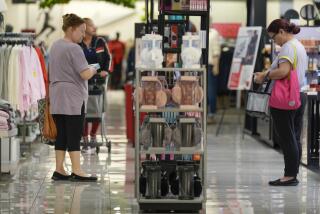Rise in Wages, Fall in Jobs May Spell Inflation
WASHINGTON — American workers got their biggest hourly wage gain in 16 years last month, but the nation’s total number of jobs declined for the first time in nearly four years, the Labor Department reported Friday.
The combination of sharp wage increases and shrinking employment, if it continues, points toward a return of inflation even as the economy is slowing down--a worrisome prospect.
That poses a dilemma for policymakers at the Federal Reserve. Boosting interest rates again to combat inflation would risk choking off economic growth that suddenly seems tenuous. But leaving rates alone in the interest of encouraging growth could send inflation skyward.
“The Fed is walking a very fine line,” said Diane C. Swonk, chief economist for Bank One Corp. in Chicago. “They don’t want to look like the enemy of growth. They want to look like the enemy of inflation.”
Despite the loss of jobs, the unemployment rate held constant at 4.2% in September, its lowest rate since 1970, as many workers returned to school.
Average hourly wages jumped by an unexpected 0.5% in September, the Labor Department said. Analysts were divided over whether that was just a one-month statistical blip or marked the long-feared arrival of wage-based inflation, which by all conventional understanding should have appeared months ago in response to the tightest job market in decades.
Historically, inflation has accelerated when unemployment has fallen so low. Because it hadn’t yet materialized during this boom, however, some economists speculated that productivity gains generated by new technologies had fundamentally changed the way the economy works.
The government said the number of payroll jobs declined by about 8,000 after a string of 43 monthly increases that frequently reached 300,000. Hurricane Floyd contributed, but government economists estimated that even without the hurricane’s disruption of the East Coast economy, job growth would have been only about 50,000, or one-fourth what was expected.
Some economists speculated that employers were no longer able to find people to fill openings, a sign that the economy was still red-hot. But others wondered whether the economy might be cooling down in response to interest rate increases earlier this year.
“I don’t think you can say which of these is occurring,” said Peter Kretzmer, senior economist at Bank of America Corp. “There are a lot of ambiguities here.”
According to Friday’s report, average hourly wages rose by 7 cents in September, to $13.37. That is the largest monthly increase since U.S. workers got an average 8-cent-an-hour increase in September 1983.
If sustained for 12 months, said Maureen Allyn, chief economist at Scudder Kemper Investments, the 7 cents would compound into an annual wage increase of 6.5%--enough to set off alarms at the Fed.
Federal Reserve Chairman Alan Greenspan has said repeatedly that he is scrutinizing labor data for any sign that wages are putting pressure on prices. Already, tight labor markets have prompted the Fed to raise interest rates twice this year, for a total of half a percentage point, as preemptive strikes against inflation.
“We’ve already moved into another phase of the expansion, one which has inflation,” said Swonk, adding that she was watching not just wage rates but rising commodity prices and the falling dollar.
A weaker dollar against foreign currencies stokes inflation by making imports more expensive for Americans to buy, but it can take as much as two years for this effect to show up in consumer prices.
But she and other economists said it was impossible to tell whether last month’s hefty wage increases would become a trend--or even what was responsible for September’s wage boost.
The hourly wage statistic is a poor indicator of real overall gains in earning power because it leaves out key items, such as managerial salaries, bonuses and benefits.
In addition, the wage statistic can post large month-to-month fluctuations that have nothing to do with underlying economic trends.
“Average hourly earnings will be a very important thing to watch next month, to see if there is a trend,” said Kretzmer. “People will be looking for a lower figure next month, 3.5% or below.”
Even more puzzling was September’s fall-off in hiring, which couldn’t be waved off as a fluke confined to just one sector. Hiring slowdowns were apparent throughout retailing, food service, manufacturing and government.
“That’s well below the trend number,” said Kretzmer. “I think it suggests that the labor market is beginning to cool a bit. Domestic demand is still strong, but the extra push is unwinding.”
That suggested the economy might finally be responding to the Fed’s two interest-rate increases, which have raised the cost of key economic activities.
Others experts said, though, that they thought the economy was not cooling down at all and that the hiring slowdown simply showed there was nobody left to hire. Consumer spending, which accounts for two-thirds of the economy, remains extremely robust.
Allyn said she is projecting “blow-out” economic growth of 4.5% for the just-completed third quarter.
“Americans are proving that it’s impossible to saturate your material wants if you’re wealthy enough,” she said. “I don’t see the economy slowing down until somebody takes a much bigger hammer and hits us on the head.”
More to Read
Inside the business of entertainment
The Wide Shot brings you news, analysis and insights on everything from streaming wars to production — and what it all means for the future.
You may occasionally receive promotional content from the Los Angeles Times.










